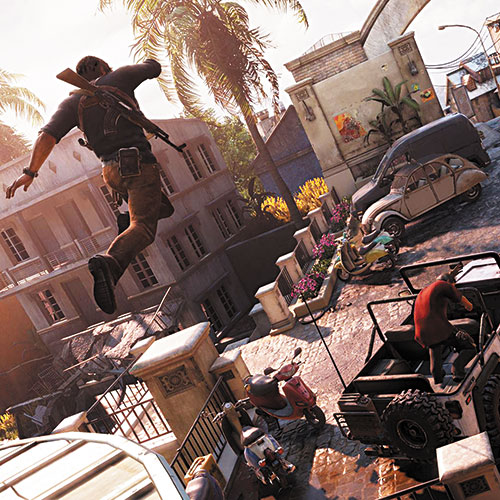Here’s one last grand adventure for PlayStation’s biggest hero

By Andrew Reiner | Game Informer Magazine
Uncharted 4: A Thief’s End
Platform: PlayStation 4
Style: 1-Player Action (10-Player Online)
Publisher: Sony Computer Entertainment
Developer: Naughty Dog
Rating: T, for Teen
The Grim Reaper’s scythe rarely falls upon treasure hunters. The earth collapses beneath their feet, arrows fly from walls, and giant boulders give chase, but these adventurous souls cannot be stopped until they locate an ancient secret. Their expeditions are brimming with rollicking fun, but their stories always end the same way: They live another day, and one less treasure is lost to the world. But unlike Indiana Jones (who is still chasing myths and legends at age 73) and Lara Croft (who is turning back the clock), Naughty Dog has said “Uncharted 4: A Thief’s End” is Nathan Drake’s final chapter. The subtitle alone paints an ominous picture for the famed hero, but what is it hinting at? Does he die? Disappear without a trace? Retire atop a mountain of gold?
That question turns “A Thief’s End” into a ticking time bomb of a narrative. As this story unfolds, we see Drake’s entire life come into frame. We get to know him intimately; we know what he’s sacrificing and what drives him.
Drake has settled down and appears to be content living out the rest of his days working nine to five and heading home to see Elena. The unexpected arrival of his older brother Sam, who was believed to be dead, pulls Drake back into the treasure hunting game. He is reluctant at first, but Sam’s life hangs in the balance, so he has no choice.
It’s a hell of a story that shifts between “Uncharted’s” patented “everything is suddenly exploding and everyone is yelling” design to the slow and heavy emotional tone of “The Last of Us.” There’s clear inspiration from “The Last of Us” in “Uncharted 4,” and it’s a better game because of it.
While Nathan and Sam are front and center for most of this journey, one of the most interesting characters to follow is Captain Henry Avery, a dead pirate who we only learn about on pieces of paper and riddles scrawled on cave walls. He’s written remarkably well by Naughty Dog. Avery has concocted the mother of all treasure hunts, which ends up being a fascinating reflection of a pirate in his prime, and a fun breadcrumb trail to follow.
The adventuring spirit is alive and well in this installment, and the revelations at the end of it all are fantastic, as they show the great lengths Avery went to protect his treasure.
“A Thief’s End” doesn’t have that big, iconic set piece moment like the previous “Uncharted” games did (i.e. the train on the cliff, the boat capsizing, and the cargo falling out of the plane), but succeeds as a collection of smaller “I can’t believe we survived that” sequences with houses crumbling, armored vehicles exploding, motorcycles racing dangerously, and Naughty Dog’s artists pulling out all of the stops to make every second of action look as chaotic and beautiful as possible. However the excitement they deliver has diminished over the years. The thrill of a platform falling apart as soon as Drake lands on it doesn’t get the blood racing as much — it’s an expected element that, by the fourth installment, seems fairly commonplace.
The action may feel somewhat routine at times, but the feeling of exploring lost worlds is heightened in this chapter. The environments are much wider, sometimes offering multiple traversal solutions. In past “Uncharted” games, I just ran forward, following the linear path laid out before me. In this game, many of the environments made me pause, analyze my surroundings, and figure out how I could navigate them.
Drake’s new grappling hook enhances the exploration, and is often tied to harrowing platforming sequences. It’s also flat out fun to use. The platforming is as briskly paced as it’s been in the past, and is often done with the world exploding around Drake. But again, this element has lost some of its magic with time.
Some of the environments are so vast that they take on the illusion of open worlds, giving the player even more freedom to explore, often with a vehicle. These areas change up the pacing nicely and embrace the essence of adventure in a slightly different way. Since Drake is often with Sam (or other characters), light team-based gameplay is periodically thrown in (think “The Last of Us”).
Drake’s hand-to-hand fighting is greatly improved, giving each punch a cringe-inducing (but satisfying) smack. The gunplay is still a little loose, but the enemies are smarter now, which means Drake either has to rely on stealth more (which works well), or strategically pick off targets before they advance or flank. Combat never feels like a thrown in chore. I enjoyed all of the encounters and found them surprisingly empowering, especially when the grapple swing is used to launch Drake onto a foe.
“A Thief’s End” is the best “Uncharted” yet, delivering a story I didn’t want to end, and an adventure that concludes with a hell of a payoff. The “wow” factor of the world exploding under Drake’s feet has diminished in the years following “Uncharted 2,” but those moments are still effective, and a true showpiece of the developer’s exquisite craftsmanship for world and gameplay design. All four of Naughty Dog’s games culminate in “A Thief’s End” in a fitting and cohesive way that fans should appreciate. I hate seeing Drake go (especially when he’s in his prime), but I’d rather see him go out on top like he is here than be tasked to find a crystal skull or some other poorly fabricated MacGuffin decades from now.











